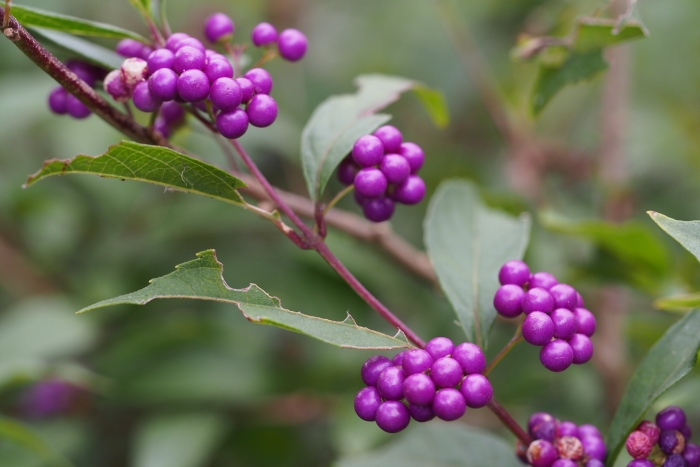Japanese Beautyberry
(Callicarpa japonica)
Japanese Beautyberry (Callicarpa japonica)
/
/

harum.koh
CC BY-SA 2.0
Image By:
harum.koh
Recorded By:
Copyright:
CC BY-SA 2.0
Copyright Notice:
Photo by: harum.koh | License Type: CC BY-SA 2.0 | License URL: https://creativecommons.org/licenses/by-sa/2.0/ | Uploader: harum.koh | Publisher: Flickr |













































Estimated Native Range
Summary
Callicarpa japonica, commonly known as Japanese Beautyberry, is a deciduous shrub native to the understory of forests and woodland edges, as well as riparian zones in East Asia, including Japan, China, Taiwan, and Korea. This shrub typically grows to a height of 4-6 feet (1.2-1.8 meters) with a similar spread and is characterized by its gracefully arching branches. The leaves are opposite, simple, and have a serrated margin. During the summer, small, inconspicuous pink to white flowers bloom, which are followed by the plant’s most striking feature: clusters of glossy, vibrant purple berries that persist into winter and are highly ornamental.
Japanese Beautyberry is valued for its stunning fruit display, which can add a splash of color to the autumn and winter garden. It is often used in ornamental plantings, borders, and as a wildlife attractant. The berries, while not suitable for human consumption, provide an important food source for birds. The plant is relatively low-maintenance, requiring minimal pruning and tolerating a range of soil conditions, though it prefers moist, well-drained soils. It thrives in full sun to part shade. While generally disease-resistant, it can occasionally suffer from leaf spot or powdery mildew.CC BY-SA 4.0
Japanese Beautyberry is valued for its stunning fruit display, which can add a splash of color to the autumn and winter garden. It is often used in ornamental plantings, borders, and as a wildlife attractant. The berries, while not suitable for human consumption, provide an important food source for birds. The plant is relatively low-maintenance, requiring minimal pruning and tolerating a range of soil conditions, though it prefers moist, well-drained soils. It thrives in full sun to part shade. While generally disease-resistant, it can occasionally suffer from leaf spot or powdery mildew.CC BY-SA 4.0
Plant Description
- Plant Type: Shrub
- Height: 4-6 feet
- Width: 4-6 feet
- Growth Rate: Moderate
- Flower Color: Pink, White
- Flowering Season: Summer
- Leaf Retention: Deciduous
Growth Requirements
- Sun: Full Sun, Part Shade
- Water: Medium
- Drainage: Slow, Medium, Fast
Common Uses
Bee Garden, Bird Garden, Border Plant, Butterfly Garden, Deer Resistant, Hedges, Low Maintenance, Potted Plant, Street Planting
Natural Habitat
native to the understory of forests and woodland edges, as well as riparian zones in East Asia, including Japan, China, Taiwan, and Korea
Other Names
Common Names: Japanese Callicarpa, East Asian Beautyberry, Japanese Mulberry, 작살나무
Scientific Names: , Callicarpa japonica, Amictonis japonica, Callicarpa mimuraskai,
GBIF Accepted Name: Callicarpa japonica Thunb.